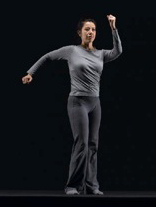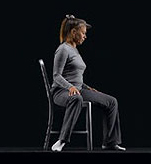Most movements work well for us because of timing. Like a good joke, a good kick of the ball into the net at the right time is what counts. You could have the biggest muscles or swing a bat in the most graceful and coordinated manner, but if you don’t have the timing to connect with the ball, you strike out.
Another factor affecting our timing habits is the pace of our movements. As we get older we naturally tend to slow down and to avoid the feeling of acceleration or rapid deceleration.
When a comedian is very funny to one part of an audience but not to another, the issue often is about timing. There is no right joke at the wrong time in a social situation. In the same way, there is no correct way to move without considering that all our movements in space are orchestrated in time. I think it is important for everyone to realize that mistiming is also a habit that you have some control over—maybe not with your jokes but definitely with your movements.
Here are a couple Change Your Age tips on how to transform your timing habits and a sample lesson from the book Change Your Age.
How to Transform Your Habits
 Tip #1: It’s important to maintain your body’s ability to accelerate. Turn your head from side to side a small amount, but rapidly. Do this just a few times so you don’t get dizzy. Look up and down about the same amount and at about the same speed. Get your inner ears familiar with the speed change. Then, when you go for a walk, go to an area that is not crowded with people or cars. Pick a short distance that feels comfortable for you to use to go fast. Swing your arms and let yourself walk as fast as you can, with big steps and a big arm swing. Start with 100 yards. Increase the amount each day. Every so often, turn your head to one side and then the other, while your arms are pumping and you’re walking fast.
Tip #1: It’s important to maintain your body’s ability to accelerate. Turn your head from side to side a small amount, but rapidly. Do this just a few times so you don’t get dizzy. Look up and down about the same amount and at about the same speed. Get your inner ears familiar with the speed change. Then, when you go for a walk, go to an area that is not crowded with people or cars. Pick a short distance that feels comfortable for you to use to go fast. Swing your arms and let yourself walk as fast as you can, with big steps and a big arm swing. Start with 100 yards. Increase the amount each day. Every so often, turn your head to one side and then the other, while your arms are pumping and you’re walking fast.
Tip #2: Sit or stand in a relaxed manner. Keep your neck and your jaw feeling soft. Look straight in front of yourself. Slowly move your eyes to a comfortable place to the right, then back again, without moving your head. Do this again, slowly. Then again, but faster. And then a few more times faster still. Keep your breathing steady. Now walk a little bit. You might feel a different sense of eye speed on the right side. Repeat this eye movement on the left side, going slower and then faster, until you can go fast. Finally, with your jaw relaxed and your breathing steady, slowly and calmly move your eyes from right to left, as if scanning the environment. Then do it very fast, without moving your head. Rest. Now if you turn your head as well as your eyes, you’ll find that you can go very quickly.
Timing Habits- Sample Lesson
This lesson asks you to be intuitive and instinctual and to trust yourself. Unlike other fitness books, you won’t find strict rules on repetitions or time limits here; I’ll suggest parameters, but the Change Your Age program is about being in touch with your body and brain—and your sense of movement.
Before you start this lesson, read through it and look to the photos for guidance. This mental rehearsal will help you unleash your physical imagination.
- GO SLOWLY—Take your time, you’ll learn more!
- INSIST ON COMFORT—If it hurts, it’s not helping you. Never try to override pain if you feel it.
- USE YOUR IMAGINATION—Allow the movement to become very clear and lucid in your mind, like a scene from a movie.
- REST FREQUENTLY—These movements, while gentle and pleasurable, may cause slight strain because you are using parts of muscles you may not have used in a long time, or you may be using them in ways that are not familiar.
- CHOOSE A COMFORTABLE SPACE—Make sure that you have space around you to move and that your clothes are loose enough to not restrain your movement.
Lesson 14: The Sitting and Turning Dance
Intention: To further explore how you sit in a chair and provide you with greater core muscle strength, better balance, and improved range of scanning.
Starting Position: Sit in your chair with plenty of room around yourself. If you have a mat, put your chair toward the back of your mat, not on your mat. Sit so that your back isn’t leaning against the back of the chair. Have your feet on the floor next to each other, a little bit apart.
1. Notice how you are sitting in the chair. While you’re sitting, turn your head from side to side and observe which side is easier.
2. Lift up the left side of your pelvis and “walk” it forward. You’ll have to push through your left leg to lift the left side of your pelvis, then begin to inch it forward.
Now do the same thing with the right side. Walk left and right a few times. Now do this movement without lifting your feet off the floor.
Can you walk both the left side and the right side of your pelvis backward? Walk one side back and then the other.
Then go a little farther back, but keep your feet on the floor. This can be the hardest part.
As you are doing this with your pelvis, make sure you really use ground forces through your feet to assist the movement.
3. Begin to walk a couple of steps forward on your sitting bones, which are the bones on the bottom of your pelvis on each side. Then walk a couple of steps backward, still keeping your feet on the floor.
Come to the middle in a place that feels neutral to you.
As a measure of your orientation, look around yourself again. Notice whether it’s easier to scan the room, turning from side to side. Maybe you can see farther around yourself, as if you’re taking in more of the environment, with an increased awareness of the space around you. Waking up deep pelvic and core muscles with new movements can affect sensations in the head and face. Some people may find that their face feels larger as well.
4. Next, with your head up and able to scan, walk your feet on the floor so that you can turn your pelvis and sit with your feet on the right side of your chair.
 Then walk yourself back. You are turning on your chair. You may be able to get back and forth in only a couple of steps.
Then walk yourself back. You are turning on your chair. You may be able to get back and forth in only a couple of steps.
Pause.
Then walk your pelvis to the left side.
Now go from side to side so that you turn completely to the right side of the chair and then completely to the left, almost spinning your pelvis in the chair.
When you come to the middle again, pause.
The next movement might make you a little dizzy, so be careful. Rest when you need to and keep breathing.
5. Again, using your feet, walk your pelvis left and right completely. Turn your head to look over your left shoulder while simultaneously turning your pelvis to the right. Then, while turning your pelvis to the left, simultaneously turn your head to look over your right shoulder.
Keep going side to side so that you’re continuously looking in the opposite way your pelvis is turning.
Come to the middle again and rest. You can rest any way you want to, leaning back into your chair or not. Turn your head to each side and feel if you can see farther.
For more movement lessons, tips and helpful routines, buy the Change Your Age book and the Change Your Age video program.
